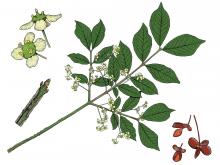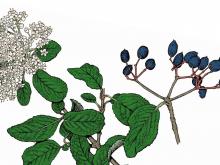Trees, Shrubs and Woody Vines
Media

Species Types
Scientific Name
Euonymus alatus
Description
Burning bush, or winged euonymus, is a nonnative shrub that has been very popular in landscaping for its bright red fall foliage. But it is invasive and spreads aggressively into natural habitats, displacing native species.
Media

Species Types
Scientific Name
Ligustrum spp.
Description
Four species of privets occur in Missouri, all are nonnative, and all are considered invasive or potentially invasive. When they invade natural habitats, they can form dense thickets that crowd out native vegetation.
Media

Species Types
Scientific Name
Forestiera acuminata
Description
Swamp privet is a straggly shrub or small tree growing in wet to swampy ground. It is quite noticeable in early spring, with the clusters of yellow flowers and bracts appearing along the gray branches before the leaves come out. In this way, it is similar in aspect to spicebush.
Media

Species Types
Scientific Name
Nyssa aquatica
Description
Water tupelo, or tupelo gum, is a large tree with a large, swollen, sometimes buttressed base, a tapering trunk, and a flattened, spreading crown. It and bald cypress are the dominant trees in Missouri’s Bootheel swamps.
Media

Species Types
Scientific Name
Viburnum rufidulum
Description
Southern black haw is an irregularly branched shrub with shiny, dark green, opposite leaves whose lower surface is paler with scattered rusty hairs, especially on the veins. It bears clusters of white flowers, which turn into bluish-black fruits.
Media

Species Types
Scientific Name
Ulmus spp.
Description
Missouri has seven species of elms that grow in natural settings. Elms have tough, shock-resistant wood. In the past, some species were favorite shade trees, which is why so many towns have Elm Streets. But elms have suffered for a century from a devastating fungal disease.
Media

Species Types
Scientific Name
Arundinaria gigantea
Description
Giant cane is Missouri’s native species of bamboo. It is scattered mostly in our southernmost counties and the Bootheel. In its low, moist habitats, it sometimes forms canebrakes — dense, nearly pure thickets.
See Also
About Trees, Shrubs and Woody Vines in Missouri
There are no sharp dividing lines between trees, shrubs, and woody vines, or even between woody and nonwoody plants. “Wood” is a type of tissue made of cellulose and lignin that many plants develop as they mature — whether they are “woody” or not. Trees are woody plants over 13 feet tall with a single trunk. Shrubs are less than 13 feet tall, with multiple stems. Vines require support or else sprawl over the ground.





















